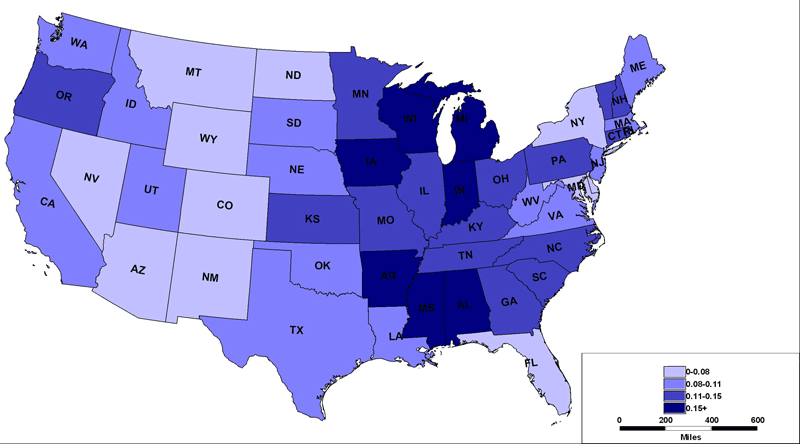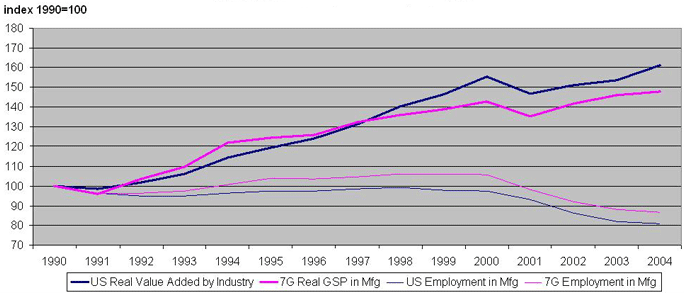Manufacturing Update
Manufacturing activity holds an outsized importance in the economy of the Midwest. The Midwest regional economy derives approximately 53 percent more than the national average of personal income from manufacturing. The map below illustrates the relative share of payroll employment in manufacturing across U.S. states.
1. Manufacturing share of total employment, 2004

Five years ago, manufacturing led the U.S. economy into an economic decline. Real output in manufacturing steeply declined even while consumer spending continued to grow, if only weakly. In both the region and the nation, sagging output translated into layoffs and net job losses. From mid-2000 to mid-2003, manufacturing employment dropped 16 percent in the nation and 17 percent in the Seventh Federal Reserve District states of Illinois, Indiana, Iowa, Michigan, and Wisconsin.
To assess the existing conditions and future prospects for manufacturing, the Chicago Fed organized a series of three conferences beginning in late 2003. The Manufacturing Assessment Project’s major conclusions were as follows:
- The manufacturing-oriented national decline beginning in mid-year 2000 was led by sagging exports (reflecting slower global economic growth) and by a precipitous drop in investment spending (driven by a traditional slowdown in growth, as well as excessive investment spending during the late 1990s, especially in high technology communications equipment.)
- The decline in Midwest manufacturing employment was in proportion to the national decline. In the past, the Midwest had experienced a steeper decline than the nation due to the region’s high concentration in manufacturing durable goods—including both capital goods machinery and autos.
- Although manufacturing employment declined proportionately in the region versus the nation, its impact was more severe in the Midwest due to the region’s heavier concentration in manufacturing.
What kept Midwest manufacturing from falling more steeply (as it had done in past recessions) during the economic downturn in 2001? High-tech production activity fell off the map nationally. This hurt some other regions more than the Midwest, because the Midwest economy is not heavily concentrated in computing and communication equipment. In addition, consumer spending on autos was buoyed by low interest rates and by automotive company sales incentives. Finally, continuing foreign competition from very low-wage countries (especially China) affected other regions such as the Southeast more severely, where there is a concentration in low-value-added industries, especially textiles and clothing.
The severity of the 2001 recession and its aftermath led some observers to believe that Midwest manufacturing had taken a negative and permanent deviation from its long- term performance. However, most argued that, aside from the unusual manufacturing orientation of this 2001 recession, there was little reason to conclude that manufacturing performance was in any way inconsistent with long-term trends. In particular, over the long term, strong real output growth in the U.S. has been achieved through robust productivity growth, especially in durable goods production. In the process, the employment share of manufacturing has been declining approximately 2 percent per year since the late 1950s.
The share of income directly derived from manufacturing activity has also been falling. Rising productivity and competitive markets have led to falling prices for manufactured goods in the U.S. Falling prices have stimulated greater domestic demand for manufactured goods, but not enough to offset falling prices. A less important but still significant factor is that a greater share of domestic demand for manufactured goods is being served from offshore.
The Midwest has shared in manufacturing productivity gains and output expansion which, in turn, have ultimately given rise to higher standards of living in the U.S. On the downside, the region’s high concentration in manufacturing employment has contributed to its slower-than-national growth of total employment and population.
An important exception to the Midwest’s similarity to the national economy is the ongoing geographic shift in automotive production from the Midwest to the South Central and Southeast regions. This shift derives from a large sales share shift from the former Big 3 automakers and their suppliers to the “new domestic” automakers, especially Toyota and Nissan, who have tended to move southward.
A follow-up automotive conference this year highlighted how the geographical shift and industry upheaval are affecting the broader automotive parts industry. The following are some of the interesting conclusions that emerged from this gathering:
- The automotive parts industry is three to four times larger than assembly operations as measured by employment.
- The auto supplier sector is paralleling the geographical shift toward the South by automotive assembly plants.
- Foreign ownership of auto parts companies is increasing.
- Both assembly plants and parts makers seem to avoid union and hostile or overly costly labor market environments, if they can do so.
- The challenge for the Midwest’s retention of the parts and assembly industry does not appear insurmountable. Shortages of skilled workers in the South are possibly forestalling more rapid investment there. So too, the bulk of the industry remains in the Midwest so that the region’s locational pull continues to be strong. Domestic auto companies are also strategically restructuring to be more competitive.
What has transpired since we began the Manufacturing Assessment Project?
Investment spending has recovered, pulling both regional and U.S. manufacturing output growth along with it. Nationally, high-tech/info-tech production has also recovered.
In the Midwest, machinery and other basic capital goods production have greatly recovered and some sectors continue to expand. Regionally, basic industrial equipment such as electrical, construction, and mining equipment are growing strongly, while automotive production continues to flag. This has created an east-west tilt, favoring economic growth in the western part of the Great Lakes economy in relation to the auto-oriented states of Ohio, Indiana, and Michigan.
As global growth has recovered, U.S. exports have also recovered, pulling along domestic manufacturing output—especially capital goods exports. Export growth in the Seventh District has outpaced the nation.
Domestic light vehicle sales have been largely flat during the current decade at 16-17 million units per year. Sales shares have continued to shift away from the former Big 3 and their suppliers, so that many states and communities that now host related production facilities remain in crisis.
Today’s robust manufacturing output growth is largely being achieved through strong productivity growth and with little expansion in the work force. As indicated by the charts below, these productivity trends are playing out in both the nation and the region. The region’s higher concentration in manufacturing may be retarding its employment and population growth in relation to the U.S., even while it is lifting household incomes and standards of living across the nation.
2. Manufacturing output and employment









